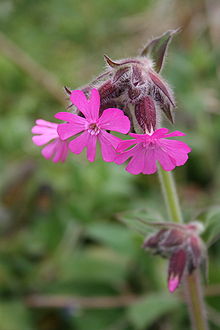Silene

Silene is a genus of flowering plants in the family Caryophyllaceae. Containing nearly 900 species,[1] it is the largest genus in the family.[2] Common names include campion and catchfly. Many Silene species are widely distributed, particularly in the northern hemisphere.[2]
Members of this genus have been the subject of research by preeminent plant ecologists, evolutionary biologists, and geneticists, including Charles Darwin, Gregor Mendel, Carl Correns, Herbert G. Baker, and Janis Antonovics. Many Silene species continue to be widely used to study systems, particularly in the fields of ecology and evolutionary biology.[3] The genus has been used as a model for understanding the genetics of sex determination for over a century. Silene species commonly contain a mixture of hermaphroditic and female (or male-sterile) individuals (gynodioecy), and early studies by Correns showed that male sterility could be maternally inherited,[4][5] an example of what is now known as cytoplasmic male sterility. Two independent groups of species in Silene have evolved separate male and female sexes (dioecy) with chromosomal sex determination that is analogous to the system found in humans and other mammals.[6][7] Silene flowers are frequently visited by flies, such as Rhingia campestris.[8] Silene species have also been used to study speciation, host-pathogen interactions, biological species invasions, adaptation to heavy-metal-contaminated soils, metapopulation genetics, and organelle genome evolution.[3] Notably, some members of the genus Silene hold the distinction of harboring the largest mitochondrial genomes ever identified.[9]
The genus Lychnis is closely related to and sometimes considered separate from Silene,[11][12] differing in the flowers having five styles (three in Silene), the seed capsule having five teeth (six in Silene), and in the sticky stems of Lychnis. Common names include campion and catchfly, the latter name based on the sticky stems.
